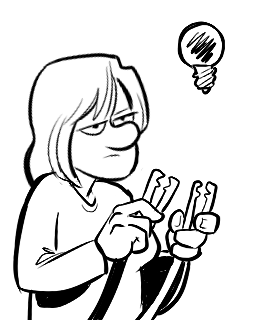Humor Writing — One Step At A Time
You don’t need a subscription to read today’s post!
This is a re-post from the Webcomics.com archive. If you’ve ever been curious about the kind of information, tutorials and advice that you’ll get as part of your subscription to Webcomics.com, this is a good example.
If you’d like to join the site, you can get a 12-month subscription for $30 — or you can get a one-month Trial for $5 … with no obligation after your 30 days expire. For less than three bucks a month, you can get a steady flow of information, tutorials and advice targeted towards your webcomic business — plus a private forum to discuss issues with other professionally minded cartoonists.
I like writing about the writing process — especially humor writing. It’s a topic that I find many people who write cartooning tutorials shy away from because it’s so difficult to quantify. But it’s something that’s essential to what we do. So even though I know I’ll never be able to write a step-by-step guide to writing the perfect joke, I like sharing little moments in which I think I’ve gotten a greater understanding of the process.
While teaching my Sequential Art class at Hussian School of Art, I had exactly that kind of moment.
 We had gotten through the midterm-project critiques more quickly than I’d anticipated, and I had class time remaining. And I hate wasting those few hours we get together every week. So, I decided to spend a little time doing some writing exercises that I had planned for an earlier class (but never got to).
We had gotten through the midterm-project critiques more quickly than I’d anticipated, and I had class time remaining. And I hate wasting those few hours we get together every week. So, I decided to spend a little time doing some writing exercises that I had planned for an earlier class (but never got to).
Exercise One — Randomizer
The first exercise was relatively straightforward. They each received one character type (clown, spy, child, hero, cowboy, maid, etc.) and one setting (moon, airport, DMV, coffeeshop). Their assignment was to write something funny that combined those two elements.
Although many of them found the Clever. Few of them found the Funny. All of them felt overwhelmed.
Exercise Two — Crowdsourcing
So we moved on to a second exercise. The were told to map out four panels. Then, they were told to start the first panel with a character and a sentence — nothing more.
Once they’d finished, I had everybody pass their paper to the person on their left. Now the instructions were to simply build on the first panel. Find the drama. Build the tension. Expand on the idea.
Once that second panel was completed, the pages got passed to the left again. Each student was now presented with a fresh two-panel set-up. The goal was simple: Keep building the tension and try to leave a clear path to a fourth-panel punchline. If they did their jobs well, the next person should be able to bring that fourth panel home with an easy slam dunk.
The results were funny. Very funny. Way funnier than the results of the first exercise. The resulting critique was punctuated by giggles, laughter — and suggestions for improvements, follow-ups and stinger gags*.
So… what happened?
What was the difference between the first exercise and the second one?
In the first assignment, the students were thrown two random elements and were put in the awkward position of finding something that connected the two. Hopefully that connection could be exploited in a humorous way.
It’s not a bad way to get the creative juices flowing — and it’s a decent writing prompt for single-panel comics. But it relies on some humor-writing chops that some of my students were still developing.
The second project, however, was different. Instead of trying to make lightning strike, the students focused on the basic craft of a comic strip:
Introduction -> set-up -> build tension -> punchline.
And, when they were simply focused on doing each step to the best of their abilities — instead of trying to be funny in the first step — the very process…
Introduction -> set-up -> build tension -> punchline.
… often brought them to a place from which they could easily identify a punchline.
Moreover, this approach could be coupled with a brainstorming technique (like Cascading Brainstorming) into your writing routine to help find the Funny more consistently. In other words, instead of doggedly following a single set-up to a single build-tension to a single punchline, a writer might experiment with several set-ups. And then, one could follow those set-ups to alternate build-tension moments (and several subsequent punchlines). Better yet, the development can happen in all directions. A good set-up might suggest an improvement on the introduction. And the way those two panels work together might suggest a path to a punchline that is a huge improvement over the initial glimmer of a joke.
And why? Because it’s hard to be funny. Sometimes it’s beneficial to break the process down to its elements and simply concentrate on doing each step to the best of your ability. My students found that focusing on the structure of setting up a joke took them to a place from which they could write better punchlines.
If you struggle with writing humor — or if you’re feeling brainlocked and need something to kickstart your creativity — maybe this is an approach that could be beneficial to you as well. If you do experiment with it, please report back and share your experiences!
——–
* Little punchlines that follow the main punchline that serve to deepen the humor.




Recent comments